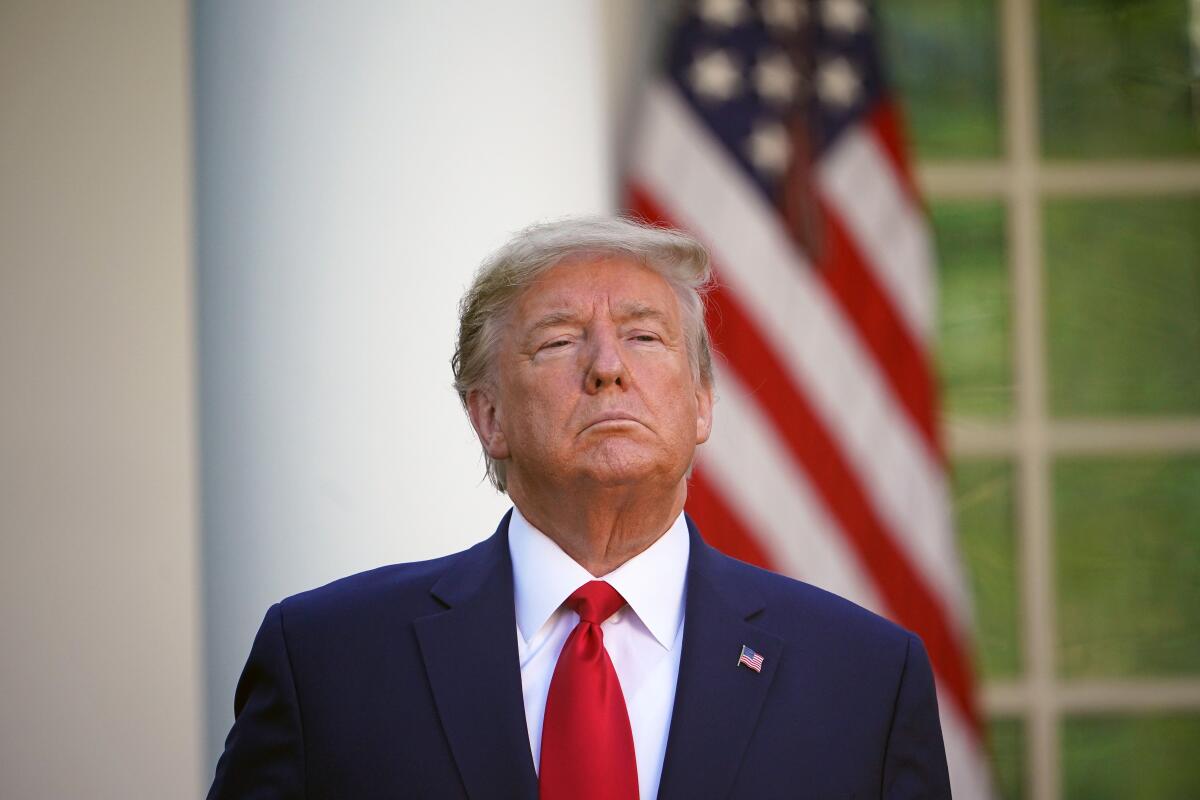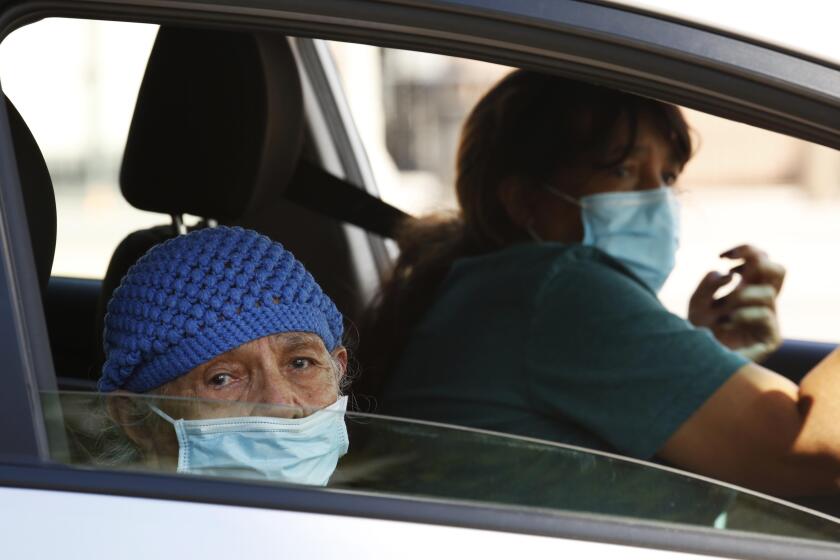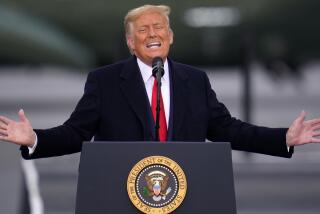Trump’s mixed messages confuse coronavirus response

- Share via
WASHINGTON — President Trump praised the “pretty good job we’ve done” when he predicted in late February that the number of Americans infected by the coronavirus would dwindle to “close to zero” in a couple of days.
Over the last weekend, one of his most chaotic since the pandemic struck, Trump drastically redefined success, claiming that if the pandemic kills between 100,000 and 200,000 Americans, “we all together [would] have done a very good job.”
The latest updates from our reporters in California and around the world
Trump has stood in front of TV cameras as much as any president in history the last two weeks, holding forth with meandering, frequently testy, near-daily news briefings that often go 90 minutes or longer while tens of millions are Americans are marooned at home, desperate for information.
The constant exposure has provided a real-time look at Trump’s decision-making process — the vacillating, the wishful thinking, the degree to which he’s influenced by whoever talked to him last or whatever he last saw on cable TV — that has long been reflected in the daily chaos of his presidency but never tested as when so many American lives were at stake.
In this case, the mixed messages from the mercurial president have left state and local leaders, as well as corporate chief executives and others, unsure what medical supplies and other support the federal government will provide as they attempt to survive the double-barreled public health crisis and economic shutdown.
“Presidents speak during times of crises,” said Julian Zelizer, a presidential historian at Princeton University. “But usually they’re very deliberative about it. This is more free flowing thought. It’s more like a radio talk show host.”
“It’s become incredibly problematic because that information flow matters a lot for how the public acts and how the resources are allocated,” he added.
On Saturday, for example, Trump set off waves of confusion in New York, the epicenter of the outbreak for now, by repeatedly saying he was considering ordering a quarantine for parts of New York state, New Jersey and Connecticut, blindsiding the governors of those states. That night, under intense criticism, he backed down.
And on Sunday, six days after Trump had said he hoped the locked-down country would be “opened up and raring to go” by Easter, Trump abruptly reversed course and extended the national shutdown guidelines for another month, until April 30.
Standing in the Rose Garden, Trump described his call for packing church pews by Easter “just an aspiration,” adding that he now expects the death toll from COVID-19, the disease caused by the coronavirus, to peak in about two weeks. Public health experts said that may be wishful thinking as well.
At Monday’s news conference, Trump said the federal guidelines “may be toughened up a little bit” but did not say how. Hours earlier, the leaders of Washington, D.C. and neighboring Virginia and Maryland had issued stay-at-home orders, joining numerous other cities and states in escalating restrictions.
Trump could not order governors and business owners to reopen — and he never explained what a federal quarantine of the New York area would entail.
But his decision to keep strong federal guidelines in place nonetheless is one of the most consequential of his presidency. It reflects a grim calculation that the potential death toll of reopening the country too soon — nearly 3,000 Americans had died as of Monday — outweighs the vast economic pain and personal sacrifices of keeping it closed.
Many inside and outside advisors had argued that Trump could relax restrictions in areas where the outbreak has yet to spread. But public health experts argued that the contagion would overwhelm hospitals and that up to 2 million Americans could die, hurting the economy as much as keeping workers home.
Trump’s two top medical advisors in the pandemic, Dr. Anthony Fauci, who heads the National Institute of Allergy and Infectious Diseases, and Dr. Deborah Birx, who is the federal response coordinator, studied the models and brought the data to Trump at the White House, Fauci said Monday on CNN.
We “went in together in the Oval Office and leaned over the desk and said: ‘Here are the data. Take a look.’ He looked at them. He understood them. And he just shook his head and said, ‘I guess we got to do it,’” Fauci said.
It was a major climb down for Trump. He started last week by repeatedly insisting “we cannot let the cure be worse than the disease itself.” When he set Easter Sunday as a loose deadline to reopen businesses, he said scientists like Fauci would close the country for a year or two if they had their way.
“We’ve never closed down the country for the flu,” Trump said last week. “So you say to yourself, what is this all about?”
Trump, as he often does, spent hours on the phone with conservative pundits and business leaders, seeking feedback. When he saw that Vice President Mike Pence, who heads the coronavirus task force, had planned a call with hedge fund managers and Wall Street executives, Trump jumped on the call, according to a White House official who spoke on condition of anonymity to describe the conversation.
Some on the call warned that the economy was sinking faster than at any time in history. Trump needed little convincing, according to the official, who said the comments reinforced Trump’s belief that he could safely relax social distancing guidelines.
“Outside voices were confirming what he wanted to do anyway, which is get this economy going,” said Stephen Moore, who advises Trump on the economy and served on his 2016 campaign. “There was a real campaign to get him to [lift the guidelines]. A lot of people, including myself, were making the point that a six-, eight-, 10-week shutdown would be catastrophic.”
At a moment in which viewers are eager for facts about the coronavirus outbreak, nightly news programs and other venerable formats are delivering.
The voices came from inside as well. Larry Kudlow, Trump’s chief economic advisor, was a strong advocate for relaxing the guidelines, according to several people close to Trump or the White House.
To many allies who had Trump’s ear, even a small gesture could help calm the roller-coaster stock markets and the nerves of business owners forced to shut down for an indefinite period.
“He’s trying to send a message that we’re going to come back,” said a lobbyist with close ties to the administration. “This is not going to be prolonged till the end of time.”
But others were scared that Trump would make the disaster worse. They feared that setting an unrealistic deadline would unsettle the business climate and that Trump’s insistence that some regions could safely return to work would weaken the resolve of other Americans stuck at home.
One former White House official said Trump’s reelection campaign advisors are terrified that the coronavirus outbreak, which so far has hit largely Democratic coastal cities hardest, will soon scythe across the rural areas that remain deeply loyal to Trump.
The advisors have warned Trump that the political consequences at the ballot box in November will be even worse if he is seen as too lax.
“Pay attention. You’re going to lose the election,” the former official said, summarizing the intervention.
As recently as late last week, some in Trump’s inner circle thought he would recommend allowing restaurants, bars and other small businesses to reopen by mid-April in parts of the country so far spared by the virus.
Trump struggled openly. “You know, I get it from both sides, in all fairness, and maybe it’s a combination of both,” he said Thursday, suggesting he was trying to find an elusive middle ground.
Ultimately, Trump could not split the difference. His old talking point — that COVID-19 was no worse than the flu — was shattered by images of ailing celebrities and overrun hospitals, including the Elmhurst Hospital in Queens, N.Y., where Trump grew up.
Elders and caregivers both need help during the coronavirus pandemic. Here are some tips, as well information of how the stimulus bill affects seniors.
“Body bags all over, in hallways. I’ve been watching them bring in trailer trucks — freezer trucks, they’re freezer trucks, because they can’t handle the bodies, there are so many of them,” Trump said Sunday of TV coverage of the horrors at Elmhurst.
By Monday, Trump was quoting worst-case scenarios, suggesting 2.2 million Americans could die if people returned to work and school too early. Some of the projections were published weeks ago, influencing the initial decision on March 16 to recommend strict social distancing.
But Trump acted as if the model was new, only revealed to him on Sunday by Fauci and Birx.
“I used to say, a lot of people said, ‘Could you just have kept [normal life] going? Like the flu, like a bad case of the flu, a really bad case?’” he said Monday on “Fox & Friends.” “And the answer came in yesterday ... 2.2 million people could have died.”
Trump said he is relying on the experts. But while Fauci has warned that the coronavirus runs on its own schedule, Trump couldn’t resist setting a new deadline.
“We think by June 1, a lot of great things will be happening,” he said.
More to Read
Get the L.A. Times Politics newsletter
Deeply reported insights into legislation, politics and policy from Sacramento, Washington and beyond. In your inbox three times per week.
You may occasionally receive promotional content from the Los Angeles Times.














